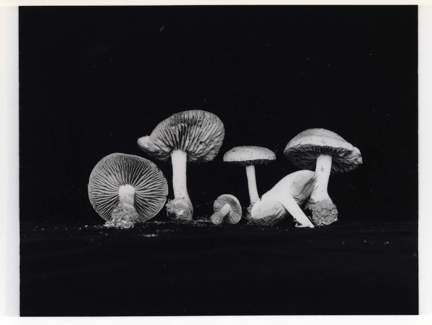 Hebeloma sarcophyllum (Photo: A.H. Smith)
Hebeloma sarcophyllum (Photo: A.H. Smith)Taxonomy
Full name: Hebeloma sarcophyllum (Peck) Sacc., Syll. Fung. 5: 804 (1887)Genus: Hebeloma
Section: Porphyrospora
Basionym:
Agaricus sarcophyllus Peck, Ann. Rep. N.Y. St. Mus. nat. Hist.: 96 (1872) ["1873"]
Types: UNITED STATES: New York: Rensselaer County, Greenbush (approx. 42.6133°N, 73.7312°W, alt. approx. 100 m a.s.l.) on boggy, grassy soil, Jun. 1869, C.H. Peck (Holotype. herbarium acc. no. NYS-F-002715, HJB1000259).
Homotypic synonyms:
- Sarcoloma sarcophyllum (Peck) Locq., Flore Mycologique Vol III - Text. Cortinariales A: 146 (1979) ["1977"]
- Derminus sarcophyllus (peck) Henn., Hymenomycetineae: 243 (1898)
- arrow_drop_downarrow_drop_upEtymologyFrom sarco- (Greek), meaning ‘flesh, fleshy’ and philo (Greek) meaning ‘loving, fond of’.
- arrow_drop_downarrow_drop_upDiagnosisPileus fleshy, short and obtusely conical or convex, smooth, white, the margin incurved; lamellae broad, not crowded, attached, deeply emarginate, dingy, flesh-color; stipe equal, smooth, white, firm, stuffed, mealy-squamulose above, spores smooth, very dark ferruginous. Height 1'-2' [25.4-50.8 mm], breadth of pileus 6''-18'' [12.7-38.1 mm]. Wet grassy ground. Greenbush. June. Taste slightly bitter. The edge of the lamellae is slightly eroded. Their deep emargination and peculiar color make this a strongly marked species. At first sight, it looks like a small Psalliota. (Plate 1, figs. 7-11.)
References
Description
- arrow_drop_downarrow_drop_upThresholds
Description of Hebeloma sarcophyllum based on 6 collections
- arrow_drop_downarrow_drop_upMacroscopic descriptionPileus: (15) 31–49 (70) mm diameter; shape convex, occasionally applanate, umbilicate or broadly umbonate; characters often pruinose; margin characters often involute, occasionally smooth; viscosity tacky when moist; colour variation unicolour; colour at centre Not recorded.
Lamellae: attachment often emarginate, occasionally adnate; maximum depth not recorded; number of complete lamellae 40–52; presence of tears absent; white fimbriate edge present.
Cortina presence: no.
Stipe: (25) 37–44 (50) x (3) 4 (6) {median} x (3) 4 (6) {basal} mm; stipe Q 8.3–13.3; base shape often cylindrical, occasionally bulbous or clavate; floccosity often pruinose at apex, occasionally floccose, floccose at apex or velute; rooting no; thick rhizoids at base absent;
Context: Texture firm; stipe interior stuffed; stipe flesh discolouring no; slenderness measure 11.6–11.9; smell odourless; taste weakly bitter where recorded.
Spore deposit colour: Not recorded.
Exsiccata characters: Not recorded.
- arrow_drop_downarrow_drop_upMicroscopic descriptionSpores: shape amygdaloid or limoniform; colour in microscope often yellow brown, occasionally brown or yellow; guttules often no, occasionally yes. papilla very strongly; Spore Code: O3 (O4); (P2) P3; (D1) D2 (D3).
Basidia: 21–28 (29) x 6–8 (9) μm; ave. Q 3.2–3.7; spore arrangement 4 spored;
Cheilocystidia: main shape clavate-lageniform or clavate-ventricose, often gently clavate, occasionally cylindrical or ventricose; special features observed often many collapsed in exsiccata, occasionally conglutinate or irregular; cheilocystidia ratios: A/M = 1.34–1.56; A/B = 0.82–1.30; B/M = 1.09–1.68.
Pleurocystidia: none seen.
Ixocutis: epicutis thickness (measured from exsiccata) up to 90 μm; ixocutis hyphae width up to 5 μm; ixocutis hyphae encrustation yes; shape of trama elements beneath subcutis cylindrical up to 15 μm wide.
Caulocystidia: Similar to cheilocystidia but larger, up to 60 μm.
- arrow_drop_downarrow_drop_upSpore measurements
- arrow_drop_downarrow_drop_upCheilocystidia measurements
- arrow_drop_downarrow_drop_upHabitat and distributionHebeloma sarcophyllum's preferred habitat appears to be woodland with soil and litter or grassy soil. Where only one possible associate was recorded, the most commonly recorded associate was Quercus (66.7%) but Pinus (33.3%) were also recorded. In these cases the most commonly recorded families were Fagaceae (66.7%) and Pinaceae (33.3%). Overall the most commonly recorded families are Fagaceae (66.7%) and Pinaceae (33.3%) The growth habit of our collections was often scattered or solitary.
According to our current collections, the species is found only in Northern America. On the continent, collections has been found in the WWF biomes The World Wildlife Fund (WWF) have divided the world into 867 terrestrial ecoregions. The ecoregion here is estimated by mapping from the GPS coordinates of the collection using data made available by Dinerstein et al (2017). Use this webtool to explore the ecoregions visually or see a full list of current ecoregions on Wikipedia. temperate grasslands, savannas & shrublands (50.0%) and temperate broadleaf & mixed forests (50.0%), specifically including the ecoregions: Southeast US conifer savannas (50.0%) and Northeast US Coastal forests (50.0%). From collector information, it appears collections have been found only in the 1.4 Forest – Temperate IUCN habitat We map from the collector's description of the habitat to the International Union for Conservation of Nature (IUCN)'s definition using a standardised set of rules. Please see this page for a full list of IUCN habitats.. Within Northern America we have records from Northeastern U.S.A. (Michigan and New York) and Southeastern U.S.A. (Florida).
- arrow_drop_downarrow_drop_upCommentaryPeck described the lamellae of Agaricus sarcophyllus as flesh-colored but also remarks on its appearance as being like a small Psalliota. It may be assumed that he was referring to the pinkish hue of the young lamellae that would then become darker red-brown as the spores matured, a color that would eventually disappear on the dried specimens. This color of the spores when fresh, and the eventual disappearance of the color is typical for Hebeloma sect. Porphyrospora, the section to which Hebeloma sarcophyllum should be referred. For molecular phylogenetic analyses including H. sarcophyllum, please refer to Eberhardt et al. (2020, 2021b). This species is extraordinary as a rare representative of this section outside the western Pacific Rim (Eberhardt et al. 2020, 2021b). Hebeloma porphyrosporum is also a representative of this section from outside the western Pacific Rim, from southern Europe. For many years these two species were synonymized (Josserand and Smith 1941), but it is now clear that they are distinct. We are not aware of any heterotypic synonyms.
Geographic distribution
Phenology
- arrow_drop_downarrow_drop_upAdditional cited collections